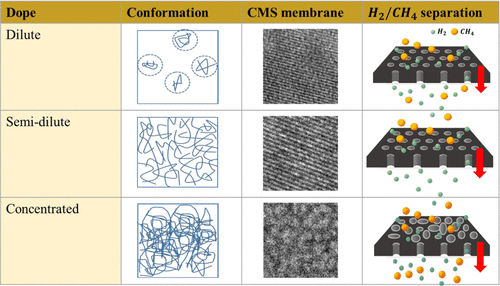当前位置:
X-MOL 学术
›
ACS Appl. Mater. Interfaces
›
论文详情
Our official English website, www.x-mol.net, welcomes your
feedback! (Note: you will need to create a separate account there.)
Insights into the Role of Polymer Conformation on the Cutoff Size of Carbon Molecular Sieving Membranes for Hydrogen Separation and Its Novel Pore Size Detection Technology
ACS Applied Materials & Interfaces ( IF 8.3 ) Pub Date : 2021-01-22 , DOI: 10.1021/acsami.0c21338 Yu-Ting Lin, Jing-Yi Li, Hui-Hsin Tseng, Ming-Yen Wey
ACS Applied Materials & Interfaces ( IF 8.3 ) Pub Date : 2021-01-22 , DOI: 10.1021/acsami.0c21338 Yu-Ting Lin, Jing-Yi Li, Hui-Hsin Tseng, Ming-Yen Wey

|
In this study, three polymer precursor conformations, dilute, semi-dilute, and concentrated, were used to fabricate carbon molecular sieving (CMS) membranes via a fixed carbonization protocol. The effects of the precursor conformation on the microstructure of the resultant CMS membranes were characterized by Raman analysis. Their ability to separate light gases, such as H2/CH4 and H2/N2, was assessed with a single-gas system. Additionally, a novel method was proposed to detect the cutoff size of the CMS membranes created in this study. The method combined high-resolution transmission electron microscopy (HR-TEM) and a focused ion beam (FIB) system. Finally, due to the semi-dilute solution’s denser polymer chains and lack of severe polymer entanglement, highly graphited CMS membranes with excellent gas separation performance were successfully synthesized using a semi-dilute polyetherimide dope solution. Interlayer distances in the carbon matrix were visualized and measured using our novel probing tool (HR-TEM and FIB) and software. The CMS membrane fabricated with a semi-dilute dope exhibited the best gas separation performance of the tested membranes. It had the most ordered carbon sheet orientation and exhibited a superior selectivity of H2/CH4 = 293 with a hydrogen permeability of 1138.7 Barrer, far surpassing the reported permselectivity of other membranes. We believe that the high H2/CH4 selectivity presented here is unprecedented for CMS membranes reported in the literature.
中文翻译:

聚合物构象在碳分子筛膜分离氢截留尺寸上的作用及其新型孔尺寸检测技术的洞察
在这项研究中,通过固定的碳化方案,使用了三种聚合物前驱体结构(稀,半稀释和浓缩)来制造碳分子筛(CMS)膜。通过拉曼分析表征了前体构象对所得CMS膜的微观结构的影响。它们分离轻质气体(如H 2 / CH 4和H 2 / N 2)的能力,使用单气系统进行了评估。此外,提出了一种新的方法来检测在这项研究中创建的CMS膜的截止大小。该方法结合了高分辨率透射电子显微镜(HR-TEM)和聚焦离子束(FIB)系统。最后,由于半稀释溶液的聚合物链更密,并且没有严重的聚合物缠结,因此,使用半稀释聚醚酰亚胺涂料溶液成功地合成了具有优异气体分离性能的高石墨化CMS膜。使用我们新颖的探测工具(HR-TEM和FIB)和软件,可以可视化并测量碳基质中的层间距离。用半稀释浓液制成的CMS膜表现出测试膜的最佳气体分离性能。2 / CH 4 = 293,氢渗透性为1138.7 Barrer,远远超过了其他膜的渗透选择性。我们认为,对于文献中报道的CMS膜,此处呈现的高H 2 / CH 4选择性是前所未有的。
更新日期:2021-02-03
中文翻译:

聚合物构象在碳分子筛膜分离氢截留尺寸上的作用及其新型孔尺寸检测技术的洞察
在这项研究中,通过固定的碳化方案,使用了三种聚合物前驱体结构(稀,半稀释和浓缩)来制造碳分子筛(CMS)膜。通过拉曼分析表征了前体构象对所得CMS膜的微观结构的影响。它们分离轻质气体(如H 2 / CH 4和H 2 / N 2)的能力,使用单气系统进行了评估。此外,提出了一种新的方法来检测在这项研究中创建的CMS膜的截止大小。该方法结合了高分辨率透射电子显微镜(HR-TEM)和聚焦离子束(FIB)系统。最后,由于半稀释溶液的聚合物链更密,并且没有严重的聚合物缠结,因此,使用半稀释聚醚酰亚胺涂料溶液成功地合成了具有优异气体分离性能的高石墨化CMS膜。使用我们新颖的探测工具(HR-TEM和FIB)和软件,可以可视化并测量碳基质中的层间距离。用半稀释浓液制成的CMS膜表现出测试膜的最佳气体分离性能。2 / CH 4 = 293,氢渗透性为1138.7 Barrer,远远超过了其他膜的渗透选择性。我们认为,对于文献中报道的CMS膜,此处呈现的高H 2 / CH 4选择性是前所未有的。











































 京公网安备 11010802027423号
京公网安备 11010802027423号